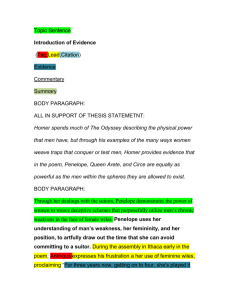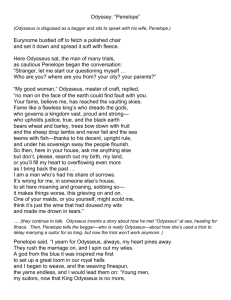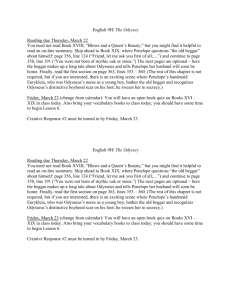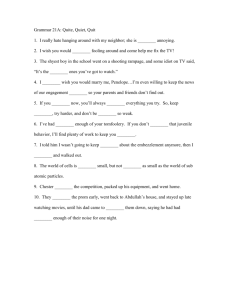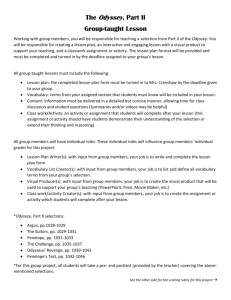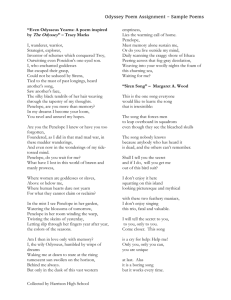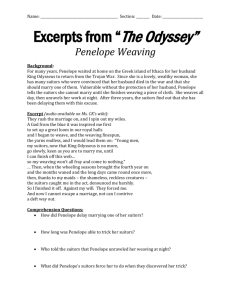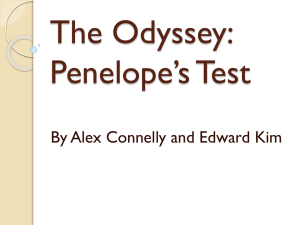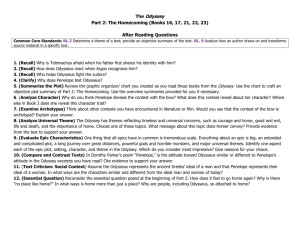weaving punishment
advertisement
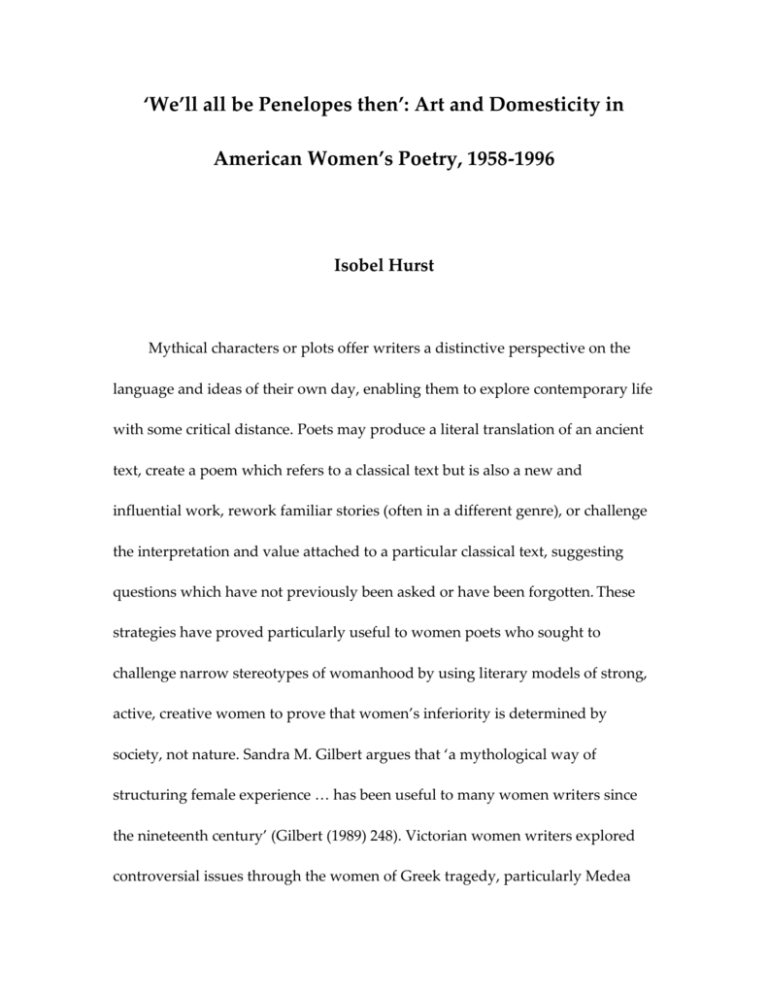
‘We’ll all be Penelopes then’: Art and Domesticity in American Women’s Poetry, 1958-1996 Isobel Hurst Mythical characters or plots offer writers a distinctive perspective on the language and ideas of their own day, enabling them to explore contemporary life with some critical distance. Poets may produce a literal translation of an ancient text, create a poem which refers to a classical text but is also a new and influential work, rework familiar stories (often in a different genre), or challenge the interpretation and value attached to a particular classical text, suggesting questions which have not previously been asked or have been forgotten. These strategies have proved particularly useful to women poets who sought to challenge narrow stereotypes of womanhood by using literary models of strong, active, creative women to prove that women’s inferiority is determined by society, not nature. Sandra M. Gilbert argues that ‘a mythological way of structuring female experience … has been useful to many women writers since the nineteenth century’ (Gilbert (1989) 248). Victorian women writers explored controversial issues through the women of Greek tragedy, particularly Medea and Antigone; suffering, outspoken, violent and troubling female characters such as Clytemnestra, Medea and Electra make Greek tragedy a perennially rich resource for those who undertake ‘the aggressive act of truth-telling from a woman’s experiences’ (Blau DuPlessis (1979) 284). Explorations of the motherdaughter relationship often draw on Demeter and Persephone, as in Rita Dove’s Mother Love (1995); the tales of Orpheus and Eurydice, and Apollo and Daphne, offer a variety of themes, including the connection between poet and muse or singer and song, love, death, metamorphosis.1 In the reception of ancient texts in twentieth-century poetry Homer is perhaps the prominent author (followed by Ovid): the variety of poems inspired by the Iliad and the Odyssey is evident in anthologies such as Nina Kossman’s Gods and Mortals (2001) and Deborah de Nicola’s Orpheus & Company (1999). Much changed for women between the 1850s and the 1950s, not least access to higher education. The women poets discussed here were all educated at least to degree level; some hold postgraduate degrees; several have taught literature or creative writing at universities. Some attended classes in which poetry was represented as a career choice – learning to be a poet was ‘a form of professional training linked with the institutional and curricular study of literature’ (Britzolakis (1999) 73). Nevertheless, they were expected either to give up poetry 1 For women poets’ responses to the Apollo and Daphne myth, see Fowler (2005). for domestic life or to model themselves on eccentric spinster poets like Emily Dickinson, Marianne Moore and Elizabeth Bishop. In the postwar period prevalent (American) notions of femininity, reinforced by popular Freudian theories, were not that far from the Victorian Angel in the House: ‘every woman’s magazine in the country preached the joy of wifehood and the creativity of domesticity for women’ (Ostriker (1986) 58). Despite the popularization of personal themes in the ‘confessional’ poetry of Robert Lowell, John Berryman, Allen Ginsberg and Anne Sexton, the American women poets who came of age in the 1950s and 1960s experienced difficulties in getting serious consideration for a poetry based on the personal and the domestic. Like their nineteenth-century predecessors, women writers found that classical models enabled them to give their poems a culturally sanctioned authority and to articulate ideas about gender which clashed with current proprieties. Women who attended university and began to write poetry in the 1950s and 1960s found that dominant New Critical principles favoured the work of male modernists like Eliot whose poems were regarded as impersonal, not autobiographical; the kind of condensed complexity which rewards close reading was essential; intellectual content was more highly valued than emotional affect. Looking back on this period, Rich comments ‘I had been taught that poetry should be “universal,” which meant, of course, nonfemale. Until [the late fifties] I had tried very much not to identify myself as a female poet’ (Rich (1979) 44). In the 1960s, ‘confessional’ poets like Robert Lowell, whose poetry seminars were attended by Anne Sexton and Sylvia Plath, chose to write in the first person about their lives and emotions, often drawing on their experiences of mental breakdown and psychoanalysis, and claiming a different kind of universality based on analogies between the speaker’s psychic history and a collective history (Britzolakis (1999) 3). Elizabeth Dodd argues that women poets such as H.D., Louise Bogan, Elizabeth Bishop and Louise Glück have created a kind of ‘personal classicism’, a compromise between these two schools: they ‘combine personal impulses (those that appear in confessional poetry) with careful elements of control that allow them to shape and frame – and mute – what are at their core romantic, personal poems. Those elements chosen to mitigate the personal center tend specifically to mute or conceal the autobiographical details in the poetry and to imply a more “universal” approach.’ (Dodd (1992) 1-2). Attempts to define the female self in poetry by American women of the 1960s and 1970s often subvert traditional mythological portrayals of women. Alicia Ostriker argues that such revisions, challenging both the gender stereotypes enshrined in myths and the accusation that women poets can only write on a small scale about their own lives, enable cultural change: ‘These poems generically assume the high literary status that myth confers and that women writers have been denied because they write “personally” or “confessionally.” But in them the old stories are changed, changed utterly, by female knowledge of female experience …’ (Ostriker (1982) 73). The myths are changed, that is, not only from their ancient versions but also from their modernist incarnations in the works of Yeats, Joyce and Eliot, who ‘use myth as a framework by which a total culture can be organized’, whereas ‘postmodern use of myth is distinguished by attention to inwardness, … to learning to inhabit a world, not creating one’ (Blau duPlessis (1979) 299). The women poets discussed here use Penelope as a model for their explorations of women’s changing attitudes towards marriage and of the difficulty of reconciling the demands of art and domestic life. They do not seek to match the scale of Homeric epic – whether the form in which they explore the ‘inwardness’ of Penelope is a dramatic monologue or a postmodern lyric, their poems usually comprise approximately thirty to forty lines and frequently point to a connection between the ancient Greek heroine and the modern woman. Reworkings of the androcentric mythology of the ancient world proved indispensable for the feminists who fought against restrictions on women’s identity in the second half of the twentieth century. In her essay ‘When We Dead Awaken: Writing as Re-Vision’ (1971), Adrienne Rich argues that ‘Re-vision – the act of looking back, of seeing with fresh eyes, of entering an old text from a new critical direction – is for women more than a chapter in cultural history: it is an act of survival’ (Rich (1979) 35). Before looking at the women poets who attempt such re-visions, exploring art and domesticity through the figure of Penelope, it is worth considering Sylvia Plath, a woman poet whose struggle to combine the identities of perfect wife and mother and serious poet has frequently been read as a tragedy; this interpretation derives from Plath’s biography and also from poems in which she identifies with tragic figures such as Clytemnestra, Medea, Electra and Orestes: 2 Torn between her acquiescence in the decorum of the fifties and her ambition to become a great artist, between modest pride in her poethusband’s power and immodest competitiveness toward him, between scholarly admiration of an often misogynist male modernist tradition and secret anxiety about that tradition, Plath seems always to have been doomed to suffer in her own person the sexual battle that marked the century in which she was born. (Gilbert and Gubar (1994) 270) Taking Plath as an example indicates that, whereas the power of tragic heroines to shock, and to challenge notions that women are naturally weak and 2 See Bakogianni, Chapter 12 (above) on Plath and Electra. non-violent, worked well for writers who needed to kill the Angel in the House (as Woolf expressed it), for a writer in the age of psychoanalysis identifying with tragic figures can lead to a reductive emphasis on the poet’s life, and the overall impression is one of pathos rather than strength. If a woman poet wants to write about artistic and domestic success, a different model is needed: ‘to be a female human being trying to fulfill traditional female functions in a traditional way is in direct conflict with the subversive function of the imagination. … There must be ways, and we will be finding out more and more about them, in which the energy of creation and the energy of relation can be united’ (Rich (1979) 43). The Odyssey’s comic vision can be empowering, as Alicia Ostriker notes in ‘Homecoming’, from A Woman Under the Surface (1982): My husband … happens to be The man who wrote the brutal but idealistic Iliad, while I am the woman who wrote The romantic, domestic Odyssey, filled With goddesses, mortal women, pigs, and homecoming. (31-5) Why Penelope? Giving a voice to a mythical character who is silent or who says little in the original text is a strategy frequently used by women poets who are attempting to deconstruct the old myths which exclude them and construct new ones. For example, Linda Pastan’s series of poems based on the Odyssey includes a dramatic monologue by Odysseus’s dog as well as poems written from Telemachus’ point of view or Circe’s. As a poet rather than a critic, Pastan does not have to ‘stick to the text as we have it, but invents new episodes to support her reading … [and] retells the episodes that are in the poem, but adds a new perspective, evoking a subjectivity that is absent from the original’ (Murnaghan (2002) 138). Penelope, whose thoughts and feelings remain largely hidden, is a major female character in a canonical poem who is open to reinterpretation. Recent scholarship on Penelope emphasizes her similarity to Odysseus, and the complexity and indeterminacy of her character and motivations.3 ‘She too is a trickster, fabric/ator, spinner of artifice. She too has a story to tell, woven into a weave of wiles. For her, home is not unnarratable, but the time and space of the coming and going of men – the absent husband, the growing son, the pressing suitors, the dying father-in-law’ (Friedman (1990) 1). Her domestic stability is threatened, but her weaving, unweaving and reweaving prevents the break-up Heitman (2005) 2. See also Felson (1997). One of the most debated problems is how long it takes her to recognize that the beggar who has arrived at the palace is Odysseus himself. ‘The sheer amount and variety of critical commentary generated by this opening is evidence of its importance to the interpretation of the poem’ (Doherty (1995) 33), yet it is not a question which appears in the poems discussed here. 3 of her family. Penelope’s web is ‘not only a symbol of the female sphere of influence and the traditional idea of familial order that Penelope seems to accept and represent in the poem, but also the very weapon which she uses in order to protect and maintain this kind of order by deceiving those who threaten it’ (Pantelia 496-7). However, her life offers possibilities for exploring unhappiness as well: she is isolated and persecuted by the suitors, and the weaving she spends so much time on is associated with the anticipation of Laertes’ death. Women poets’ identification with Penelope can be uneasy as well as celebratory: the Penelopes in poems by Linda Pastan, Jorie Graham, Louise Glück, Angela Jackson, Cynthia Macdonald and Eve Merriam range from a resourceful, creative figure, worthy of emulation, to a poor substitute for the more fantastic characters in the Odyssey. As readers, women often ‘experience the pull of the narrative to identify with Odysseus’ (Doherty (1995) 29). An active, adventurous hero seems a more attractive model than the deserted heroine: ‘Within the quest plot, men might do anything: literature tells us all they have done. Within the marriage plot women might only wait to be desired, to be wed, to be forgotten’ (Heilbrun (1990) 108). The woman poet wants to be the lover, the singer, but tradition places her as the beloved, the song. In ‘The Eyes of Laura Mars: An Orchid Myth’ (a poem dedicated to Adrienne Rich), Diane Wakoski writes: … there is no myth which allows women to be the charmed singer, none which allows her to go after love. She can be the sorceress who beguiles loves, or Penelope who waits, but she can never be the poet, singer, questing lover. (17-22)4 In Eve Merriam’s ‘Speaking of Marriage’ (1958), the speaker rejects identification with both the patient, suffering Penelope and the fakely glamorous Circe. She mocks Ulysses’ dream of returning home to a clean, scented castle: real life, she argues, involves squabbling children, frying smells and messy drawers. She wants to be a traveller like Ulysses, to exchange places with him: ‘wanderer I would also be / with you to return to as my key’ (26-7). The problem is how to seek adventure in the prosaic modern world: but how to tread the dusty city blocks and greenplunge out to sea? 4 Cited from Wakoski (1991). Beloved bedeviled Ulysses, we share a perplexity. (30-33) In identifying with Penelope, the poet may have to abandon her dream of becoming Odysseus, as Linda Pastan explains. Even though the first time she heard the story of the Odyssey, she was ‘half in love with Penelope’, she also wanted to be the hero, ‘the one to have adventures out in the world, not the one who remained at home, watching at a window or pacing a widow’s walk. But coming of age as I did in the ’50s, it seemed to me that as a woman of my times I was destined to be Penelope’ (Pastan (1996)). In her poem ‘You Are Odysseus’, Pastan expands on this perception that the rigid gender roles of 1950s America do not allow for epic adventures. She refigures Odysseus' journey home as his daily return from work, ‘tentative, a little angry’ (3), followed by his departure each morning. The poem suggests that these absences involve both geographical and emotional distance, creating a gendered split between the masculine world of work and the feminine world of home (perhaps also a contrast between city and suburb). This divide is emphasized by the speaker’s prediction that their son will soon join his father in the daily journeys, leaving her alone at home. However, Penelope does not regret that she is a woman who has to remain at home rather than a man going to the office every day. Her ambitions have been thwarted, but they were distinctly female: she had hoped to be a temptingly sexual Siren ‘on strewn sheets’ (6). She reluctantly sees that she has no power to allure through song, but has become silent and repressed: I … hide my song under my tongue – merely Penelope after all’ (8-10). 5 The unhappily silent Penelope, hiding her song under her tongue, seems to have an autobiographical resonance for the poet. Pastan gave up writing for nearly a decade to concentrate on her marriage and family, and published her first volume of poetry when she was 39: I was a product of the '50s – what I called the perfectly polished floor syndrome. … And I felt that I couldn't be the perfect wife and mother that I was expected to be, and commit myself to something as serious as my poetry, and I wasn't going to do that half-heartedly. It was all or nothing. And I stopped writing for almost ten years, and I was very unhappy about it during those years. And my husband 5 Cited from Pastan (1998). finally said he was tired of hearing what a good poet I would have been if I hadn't gotten married. Let's do something about it. (Brown (2003)) Marriage The relationship between Odysseus and Penelope can convey a wide range of attitudes to marriage, depending on what point in the story the poet chooses to enter at. It can be seen as ‘an idealized marriage between two people of comparable intelligence and tenacity’ (Doherty (1995) 40), or Odysseus’ long absence can make Penelope seem like ‘a single parent’ (Heilbrun (1985) 105). Negative versions may be articulated by other characters; for example, when seen from the point of view of the other woman, usually Circe, Penelope is belittled as a tedious housewife. The speaker of Linda Pastan’s ‘Circe’ identifies herself at once in opposition to Penelope and imagines Odysseus’ wife as a dull, practical housekeeper, to whom sheets merely signify household tasks. And though he may leave, memory will perfect me. One day the light may fall in a certain way on Penelope's hair, and he will pause wildly ... but when she turns, it will only be his wife, to whom white sheets simply mean laundry – (10-18) 6 In ‘The Suitor’, Pastan challenges Homer’s version of the myth from a different point of view, explicitly filling a gap in the original narrative: the poem begins ‘There is always a story / that no one bothers to tell’ (1-2). This character is described as ‘the younger son of a younger son, / hardly a suitor at all’ (3-4). In contrast to the other suitors, he is not greedy, or even hungry ‘except for a glimpse of Penelope’ (7). He voices explicit criticism of Odysseus, asking how he could have left Penelope. Through his eyes, she is seen as a beautiful woman whose predicament inspires pathos: a woman wasted, he thinks – those pale arms, that hair a web she might have woven 6 Cited from Pastan (1998). around her own head. (8-11) 7 Nevertheless, Penelope’s solitude is not always seen as a waste of her life. In Cynthia Macdonald’s ‘Why Penelope was Happy’, she is able to see Ulysses in a vision when she is at her loom. Knowing he is safe and far away, she takes pleasure in being by herself, moving from loom to loom as she progresses through the day (she goes from her morning’s work on Daphne to the ‘noon room’ where she will work on Apollo): To be alone in your domain – A queen within, a king without and distant – Such stately pleasure, such companied solitude. (23-5) 8 In Meadowlands (1996), Louise Glück interweaves poems about Penelope and Odysseus with a series of poems about a modern couple’s marital breakdown. Glück draws on her own experience of divorce as well as on the Odyssey, creating ‘a kind of postconfessional personal classicism – one in which the voice of the self is muted by an amplified sense of the mythic’ (Dodd (1992) 149). Glück has described Meadowlands as 7 8 Cited from Pastan (1998). Cited from Macdonald (1985). a book that was written at a time : ‘when a very long marriage was beginning to seem not likely to continue, and one of the problems of the book was that my life was giving me materials that were desolating, and what I felt as an artist was an imperative to do comedy. … [I]t was very clear to me that I had no wish to write a lacerating book about divorce. I had no wish to embody it in verse. I wanted to write my genial, forgiving, tolerant book of adult love. ... What the book ended up by being was a double narrative, in which the dissolution of a contemporary marriage, which is elaborated in a series of petulant, comic conversations and private bickerings, alternates with, is threaded through, with the story of Odysseus and Penelope’. (Cavalieri (2000)) The modern couple argue and criticize each other in poems like ‘Ceremony’, in which both voices are heard within the same poem: One thing I've always hated about you: I hate that you refuse to have people at the house. Flaubert had more friends and Flaubert was a recluse. Flaubert was crazy: he lived with his mother. (4-10) Significantly, it is one of their happiest and most harmonious moments that provokes a comparison with the Odyssey, in ‘Quiet Evening’: More than anything in the world I love these evenings when we're together, the quiet evenings in summer, the sky still light at this hour. So Penelope took the hand of Odysseus, not to hold him back but to impress this peace on his memory (6-11) More frequently, the querulousness of the modern couple fosters a sense of marital discontent which colours the poems about Odysseus and Penelope; that their marriage is not particularly happy is also indicated by several poems in which Telemachus trenchantly comments on his parents’ relationship. ‘Glück succeeds in making myth and quotidian experience illuminate each other. She shows us how much stifled rage there must have been in the familial relations among Penelope. Odysseus and Telemachus’ (Breslin (2005) 109). In ‘Telemachus’ Guilt’, Penelope emerges as full of anger, repressing Odysseus’ ‘native abandon’ (9) and provoking her son to bad behaviour by her distant coldness. Looking back on his childhood, he recalls that he felt proud of Odysseus for staying away from home although it was for ‘the wrong reasons’ (26). As an adult he recognizes that his childish cruelty in enjoying his mother’s suffering was, like her coldness, ‘a means of remaining / separate from what / One loves deeply’ (33-5). In ‘Telemachus’ Burden’ he implies that there can be no happy reunion between his parents, because Penelope’s solitariness is too deeply engrained: good luck to my father, in my opinion a stupid man if he expects his return to diminish her isolation; perhaps he came back for that. (20-4) Glück’s Telemachus repeatedly insinuates that he understands his parents and the problems within their relationship, to which they are blind – or at least Odysseus is. In ‘Telemachus’ Kindness’, he hints that their personalities are incompatible, Odysseus being ‘prone to dramatizing, / to acting out’ (20-1) and unable to appreciate ‘her courage subtly / expressed as inaction’ (18-19). Disputing the uniqueness of Odysseus and Penelope, the poems written from Telemachus’ point of view reinforce the point made by the interpolated voices of the modern couple, that the emotional isolation of husband and wife when under the same roof may be as great as that of the withdrawn Penelope, whose husband has been absent for years. Telemachus learns that a family composed of an absent or distant father and a mother who spends her time ‘hypothesizing / her husband's erotic life’ (5-6) is not uncommon: ‘my trials / were the general rule’ (8-9). Despite his apparent perceptiveness, Telemachus cannot provide a definitive account of Penelope’s life. In her son’s version, she appears cold and distant but is angry and passionate, she lacks Odysseus’ dramatic nature but is equally courageous within the constraints of her own life. There is no hint from Telemachus that this is not the long-suffering and faithful Penelope of legend, but his mother turns out to be more complex than he appreciates or is willing to admit. In ‘Penelope’s Song’, she exhorts herself to be ‘generous’ to her errant husband when he returns, because she too has found it impossible to repress her desires: ... You have not been completely perfect either; with your troublesome body you have done things you shouldn't discuss in poems. (7-10) As well as the poems from Penelope’s and Telemachus’ viewpoints, there are two narrative poems in the sequence, ‘Ithaca’ and ‘Reunion’. Although the speaker of ‘Ithaca’ is not Penelope, she seems to have access to Penelope’s consciousness, stressing that Odysseus’ physical existence is less important than his life within Penelope’s head, as her creation: ‘the unfolding dream or image / shaped by the woman working the loom’ (9-10). The less insightful suitors, ‘literal-minded men’ (12), fail to see that it is the imagined Odysseus rather than the man himself who keeps them from Penelope. The sea, too, has tried and failed to take Odysseus away, but since it took only ‘the first, / the actual husband’, not the image (16-17); the ‘deceived’ sea is an object of pity (14), as are the deluded suitors: they don't know that when one loves this way the shroud becomes a wedding dress. (20-1) ‘Reunion’, which appears to be from the point of view of an impartial thirdperson narrator, offers a more positive image of the marriage of Odysseus and Penelope than any of the other poems. After the killing of the suitors, Odysseus sends his son away and speaks not of his experiences at Troy or on his long journey, but exclusively of small things, as would be the habit of a man and woman long together: once she sees who he is, she will know what he's done. And as he speaks, ah, tenderly he touches her forearm. (10-14) Weaving Poets and critics have agreed that weaving is a useful symbol for women’s creative endeavours: ‘weaving was women’s speech, women’s language, women’s story’ (Heilbrun (1985) 103). Metaphors of spinning and weaving are used for storytelling, and Penelope is by no means the only female character in ancient literature whose weaving has been invoked by women poets. At least equally familiar is the story of Arachne (found in Book 6 of Ovid’s Metamorphoses), who claimed that her skill in weaving owed nothing to Athena, the patron of the craft, and rashly entered upon a weaving contest with the goddess. Her audacity and flawless skill in depicting the multiple infidelities of the gods in various disguises increased Athena’s anger: she punished Arachne by destroying her work and striking her repeatedly with the shuttle with which she had woven her own tale of the terrible fates of mortals who defied the gods. After Arachne was driven to hang herself, the goddess transformed her into a spider, reducing her life to a constant cycle of spinning and weaving. In Angela Jackson’s 1993 volume, Dark Legs and Silk Kisses: The Beatitudes of the Spinners, there is one poem which touches on Penelope, but the volume’s title suggests that it is Arachne’s spidery form which dominates these poems of spinning and weaving. For this African-American poet, the gods’ exploitation of mortal women carries undertones of slavery: in ‘Arachnia: Her Side of the Story’ Arachne, ‘the dusky girl from / Memphis’ (17-18) accuses Zeus of ransacking and plundering ‘the dark continent’ (10). Jackson’s Arachne condemns Athena for covering up the sins of her father with woven lies – her ‘seamy press releases’ (30) are political spin: What Athena weaves best is lies. Propaganda issued from Olympus. A thread of deception. Her stuff sticks to the history books. You believe that one? (19-24) Arachne denies that her death was suicide, claiming ‘It was a lynch- / rope, my Grecian girl wove / for me’ (41-3). The history of racial persecution in the American South is added to what Nancy K. Miller has described as Athena’s ‘phallic identification with Olympian authority’ and her destruction of ‘the woman’s countercultural account’ (Miller (1986) 273). A more grotesque version of Arachne’s punishment for using her skill at weaving to expose sexual exploitation is another tale from Metamorphoses 6, that of Philomela. In this story, Philomela herself is repeatedly raped by Tereus, the husband of her sister Procne, and can communicate the story of her violation to Procne in no other way, the brutal Tereus having silenced his victim by cutting out her tongue. When Philomela and Procne take revenge by killing Tereus’ son and feeding him to his father, the story takes on unmistakably tragic qualities. Like Arachne, however, the doomed family is reprieved, and Philomela, Procne and Tereus all metamorphose into birds. Philomela (the nightingale) becomes a figure for the poet. Whereas feminist critics have reread the stories of Arachne and Philomela as part of ‘the recuperation of subjectivity in the form of female identity as the best defense against androcentrism’ (Homans (1988) 398),9 women poets have preferred the less subversive but also less tragic figure of Penelope as the weaver of a woman’s story. As Carolyn Heilbrun suggests: ‘Helen and Penelope represent what might be called the legitimate weavers, those who weave while men make war ... Arachne and Philomela represent the defiant woman weaver, the one who will not be silenced in her only art though it costs her her life.’ Although the web woven by Helen (the other prominent weaver in the Homeric epics – Iliad 3. 121-45) represents the Trojan war from her perspective, it focuses on men as heroes and may be seen as both self-justifying and escapist. ‘In the context of the Iliad, where her marital status and social identity are ambivalent, Homans comments that Patricia Joplin, in ‘The Voice of the Shuttle is Ours’ (on Philomela), and Nancy K. Miller, in ‘Arachnologies’, both transform ‘a grand, ancient, and violated female figure into the type of a new project against violation’: see Joplin (1984) and Miller (1986). 9 Helen finds relief and escape from her sad reality by depicting on her loom images which actually record history as she herself sees it … producing an artifact which will survive and “tell her story”’ (Pantelia (1993) 495).10 In a feminist reading, her weaving appears ‘a liberating act by which she refuses to accept as adequate the external definitions of herself either as a helpless possession without any power to make or act on her own decisions or as a woman without scruples and morality’ (Roisman (2006) 10). If the stories of Arachne, Philomela and Helen associate weaving not just with remarkable creativity or with an alternative voice for the silent or silenced woman, but more ominously with punishment by the gods, male brutality and war, Penelope’s example is also both encouraging and problematic. Unlike Arachne, Penelope is not a rival to Athena – rather, she, like Odysseus, is under the goddess’s protection. Penelope’s suitors do not rape or mutilate her as Tereus does to Philomela: instead, she uses her weaving skills to keep them at a distance. There is another reason for Penelope’s prominence as a weaving woman, the idea of repeatedly undoing and redoing her work: And now it is the third year, and will be the fourth year presently, Pantelia argues that the Helen of the Odyssey, who has re-established her identity as Menelaus’ queen, no longer needs to weave her own story. Instead she ‘spins the thread which will empower other women … to weave their stories’ (496). Similarly, Penelope turns from weaving to spinning following Odysseus’ return (497). 10 since she has been denying the desires of the Achaians. For she holds out hope to all, and makes promises to each man, sending us messages, but her mind has other intentions. And here is another stratagem of her heart’s devising. She set up a great loom in her palace, and set to weaving a web of threads long and fine. Then she said to us: ‘Young men, my suitors now that the great Odysseus has perished, wait, though you are eager to marry me, until I finish this web, so that my weaving will not be useless and wasted. This is a shroud for the hero Laertes, for when the destructive doom of death which lays men low shall take him, lest any Achaian woman in this neighborhood hold it against me that a man of many conquests lies with no sheet to wind him.’ So she spoke, and the proud heart in us was persuaded. Thereafter in the daytime she would weave at her great loom, but in the night she would have torches set by, and undo it. So for three years she was secret in her design, convincing the Achaians, but when the fourth year came with the seasons returning, one of her women, who knew the whole of the story, told us, and we found her in the act of undoing her glorious weaving. So, against her will and by force, she had to finish it. (The Odyssey of Homer, tr. Lattimore; 2. 89-110) The repeated weaving and unweaving of the web is usually read in a positive way by women poets: ‘for the most part, Penelope’s poetic tradition does not interpret the web’s permanent state of incompletion as trapping Penelope in an endless cycle of creating nothing’ (Clayton (2004) 94). One exception is Eve Merriam’s ‘Speaking of Marriage’, which begins by rejecting Penelope as a model and classes the weaving as useless and dehumanizing domestic labour: that weaving weaving endlessly do and undo and at day's end all to begin again like dustmop: classic frustrate employ (3-6) 11 Angela Jackson’s ‘Spinster Song: African-American Woman Guild’ begins ‘We'll all be Penelopes then. / Weaving by day, untying by night’ (1-2). The first two stanzas suggest that this identification with Penelope is a positive one, enabling 11 Cited from Merriam (1958). women to reject the lovers who are ‘not / quite right’ (3-4). It is the male heroes who are vulnerable once their ‘cool shining shields’ are thrown aside, uncovering their ‘breakable hearts’ (7-8). As the second half of the poem begins, there is an abrupt change in tone in relation to Penelope’s weaving: It's wasteful to be Penelope. Spending days doing nothing to undo nights. (9-11) 12 Nevertheless, the endless possibilities for reinvention offered by weaving and unweaving, especially as Homer offers no description of what her woven fabric looks like, are often interpreted as Penelope trying out different stories or identities on her loom. ‘She unravels each night what she has woven that day, not only for delay, but also, metaphorically, because unlike the other weavers, she is not writing a story of male violence, but the story of woman’s free choice, and there is no narrative to guide her’ (Heilbrun 107). If, as Barbara Clayton argues, in the Odyssey ‘the weaving, unweaving, and reweaving of the shroud parallel the poetic process of oral composition itself’ (Clayton (2004) 35), they also parallel the painstaking drafting and redrafting of poets like Jorie Graham 12 Cited from Jackson (1993) and Linda Pastan. Graham is ‘famous for her repeated drafts’ (Casper (2001-2)) and Pastan states that ‘each poem of mine goes through something like 100 revisions … I want every word to have to be there’ (Brown (2003)). In ‘Ravel and Unravel’ (from The End of Beauty), Jorie Graham represents the unweaving of the web and the pause before her weaving begins again as a space Penelope comes to enjoy more than the creation. The poem is ‘a meditation on the moment just before an idea or shape crystallizes’ (Gardner (2003) 338): So it’s right, isn’t it, that she should come to love it best, the unraveling, every night, the hills and cypresses turning back into thread, then patience again, then … is it emptiness? (1-5) 13 ‘Self-Portrait as Hurry and Delay [Penelope at her Loom]’ is one of a series of self-portraits in The End of Beauty (the others include ‘Self-Portrait as the Gesture Between Them [Adam and Eve]’, ‘Self-Portrait as Apollo and Daphne’ and ‘SelfPortrait as Demeter and Persephone’). As these titles demonstrate, the selfportraits focus on opposing characteristics within a pair of characters, and 13 Cited from Graham (1987) although Odysseus is not named in the Penelope poem’s subtitle he is identified with hurry, and Penelope with ‘shapely and mournful delay’ (53). The poem’s title and form (it is divided into numbered stanzas of varying lengths) suggest forward movement interrupted by periods of stasis or reversal – ‘the threads running forwards yet backwards over her stilled fingers’ (24). Helen Vendler compares this technique to the cinematic freeze-frame and notes its aptness for the process of creating a self-portrait, alternately looking at oneself and painting or writing: ‘The alternations of consciousness as the pen succeeds the gaze are not concealed; rather, they are inscribed on the page, number succeeding number’ (Vendler (1995) 81): 1 So that every night above them in her chambers she unweaves it. Every night by torchlight under the flitting shadows the postponement, working her fingers into the secret place, the place of what is coming undone, 2 to make them want her more richly, there, where the pattern softens now, loosening, 3 to see what was healed under there by the story when it lifts, by color and progress and motive when they lift, 4 the bandage the history gone into thin air, 5 to have them for an instant in her hands both at once, the story and its undoing … (1-11) The meaning of what Penelope weaves is as much in ‘the secret place, the place of what is coming / undone,’ as it is in the temporarily existing ‘story’. Graham’s poem unravels the story of Penelope from the Odyssey in order to create such places ‘where the pattern softens’. Nevertheless, the story, with its concrete, graspable qualities of ‘color and progress and motive’ is not devalued; it is able to heal, to act as a ‘bandage’. Penelope’s resistance to closure, it turns out, is also a resistance to Odysseus, who constantly drives on towards the end of the story. She realizes that their lives after his return to Ithaca would take their story into a static mode, an ending which would be no longer narratable. The only solution is to keep unweaving the web, to keep desire alive: 15 approaching ever approaching the unmade beneath him, knotting and clasping it within his motions, wrapping himself plot plot and denouement over the roiling openness.... 16 Yet what would she have if he were to arrive? Sitting enthroned what would either have? It is his wanting in the threads she has to keep alive for him, scissoring and spinning and pulling the long minutes free… (4652) Rereading the Odyssey Seventeen years after the publication of ‘You Are Odysseus’, Pastan returned to Penelope in ‘Rereading The Odyssey in Middle Age’ (and several other poems: ‘At the Loom’, ‘The Sirens’, ‘Circe’, ‘The Son’, ‘The Suitor’ and ‘Argos’). 14The title places the speaker as a middle-aged (woman) reader returning to a familiar text and re-evaluating it as a reader who has been changed by her life experience: she is self-consciously explaining her new reception of the text. The poem begins not with Odysseus but with the unnamed Penelope, as if the reader immediately focuses on her equivalent in the text. Penelope is no longer seen as deserted wife and dutiful daughter-in-law, but as an attractive woman who might well be flirting with a younger suitor on warm 14 Cited from Pastan (1998). summer evenings. Penelope is central to Pastan’s rereadings: for example, she is an object of desire in ‘The Suitor’, and a rival for Odysseus’ affections in ‘Argos’ and ‘Circe’. In the first stanza of the poem, the speaker corrects her own previous misconception: what she had construed as Penelope creating a shawl for herself was actually a shroud for Laertes. This leads to the question of Penelope’s intentions: … Did she mean to finish it after all, unweaving less and less each night, and could that mean she wished Laertes dead? … (8-12) As readers have frequently observed, Penelope’s motives remain opaque. Pastan extends this observation by drawing the reader’s attention to the difficulties of unravelling concealed emotions or interpreting a piece of art: How can we hope to find the darker threads of her impatience or lust in the design of that nubby material? (14-16). Language is also being unravelled: the speaker opens up the theme of complex meanings by considering different uses of ‘shroud’. This uncertainty about definitions leads into a larger and more challenging question asked by Penelope, one which interrogates Penelope’s most famous quality: ‘What is faithfulness anyway?’ (30). The poem ends on a distinctly unhopeful note for Odysseus: She wonders if Telemachus will find a wife to weave a shroud for her lost father-in-law, or would the water be winding sheet enough for him? (35-8) Pastan’s rereadings, including the poems spoken by or representing other characters who comment on her, weave together several of the preoccupations of women poets in their ‘re-visions’ of the Odyssey. Her Penelope is intelligent, contemplative, sometimes frustrated by domesticity, able to escape into another world as a weaver and creator of beautiful things (although it is unclear why has chosen to weave what she does), a woman who is still relatively young and attractive. Although apparently happy in her marriage, she is desired and has at least considered infidelity – she cannot match Argos’ unquestioning devotion; she is despised as a dull housewife by women with more adventurous histories but those who live with her find her complex and impossible to define. Despite the poet’s earlier reluctance to choose between the fixed gender roles of husband and wife, Penelope’s story has evolved through retellings until she is as central to the poem as she is to her household. The long absent Odysseus is thoroughly displaced: Telemachus is more important to Penelope. By unweaving and reweaving the character of Penelope, American women poets have created a heroine who represents their struggles with the competing claims of art and home, one whose story suggests, as Adrienne Rich hoped, that it is possible to combine the ‘energy of creation and the energy of relation’.
